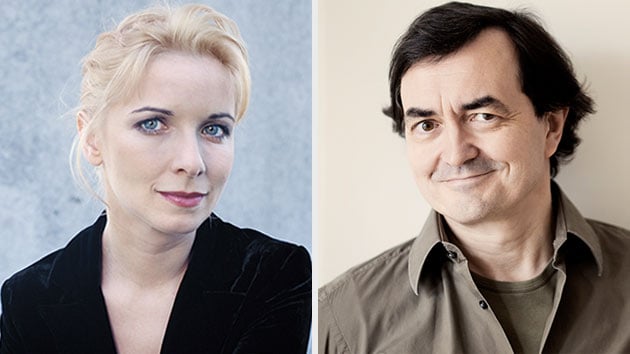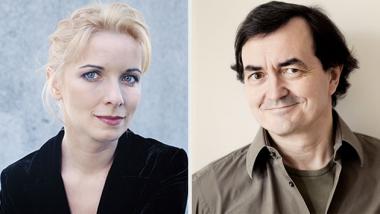
Pierre Boulez is one of the last living pillars of postwar composition. In their recital last Thursday at Zellerbach Hall in Berkeley, pianists Pierre-Laurent Aimard and Tamara Stefanovich celebrated the soon-to-be 90-year-old’s birthday and introduced what they called the “violent lightning” and “intense burnings” of Boulez’ complete, solo piano compositions.
A student of Oliver Messiaen, Boulez followed in the footsteps of the Second Viennese School. Going beyond these composers’ revolutionary organization of pitch, Boulez advocated for “total” or “integral serialism,” a means of organizing all musical parameters (rhythm, for example), using serialist techniques. This style became a major postwar musical influence in Europe and America.
Boulez’ music combines this highly intellectualized musical organization with an almost Romantic intensity. Aimard and Stefanovich outlined his stylistic development by presenting the works in chronological order.
Composed when Boulez was just 20 years old, Notations, a set of 12 miniatures, shows the influence of Prokofiev, Bartók, Debussy, and Schoenberg, in particular. One notable feature of these character pieces that Aimard emphasized in his interpretation was their obsessive repetitions of certain motives, a feature that would disappear in Boulez’ later works as he attempted to break all connections with the music of the past — including repetition.
Indeed, Boulez’ music can be an uncomfortable experience for a first-time listener looking for thematic development. Boulez’ music is fleeting and constantly escaping from the grasp of the listener. To listen to a work of Boulez is to be thrown into a constantly shifting sea. Yet you aren’t left to drown — there are rafts or desert islands where the listener can find refuge. These come in the form of isolated moments where you recognize a familiar gesture, something reminiscent of the music of the past. To listen to a work of Boulez is to be thrown into a constantly shifting sea. Yet one isn’t left to drown — there are rafts or desert islands where the listener can find refuge.
This is especially true in Boulez’ mammoth Second Sonata (1947-48), performed by the young, Yugoslav pianist Stefanovich. Like its classical predecessors, the sonata is in four movements. Stefanovich described the opening as a volcanic eruption from which lava spurts and flows. The first movement does have a passionate, Beethovenian quality, which was alive in Stefanovich’s interpretation: She approached the work not as a cerebral puzzle, but with the urgency of a Rachmaninov concerto or a Liszt sonata.
Aimard’s performance of the Third Piano Sonata from 1955-57 and 1963 was more difficult to get hold of. The work is one of the earliest examples of open form — its two movements may be played in any order, and the musical material within each movement is determined by the pianist. Aimard called the Third Sonata a “labyrinth.”
It is easy to get lost in (and even grow bored with) the new and alien musical idiom Boulez developed in his Third Sonata. The fiery outbursts of the Second Sonata are replaced with slow-paced, pointillistic groupings of individual pitches that are reminiscent of the works of Anton Webern. These are coupled with almost neurotic “games of pedal and resonance,” as Aimard described it, as the pianist must alter the timbre, attack, and loudness of each individual note.
Aimard zealously executed each of these performance instructions, becoming, almost inevitably, a slave to the composer’s micro-managing.
Finally, Aimard and Stefanovich joined forces for the composer’s 1961 Structures, Book II. The first “chapter” of the piece was a thrilling back-and-forth of statements and variations that called to mind a dueling piano contest. The second chapter, however, presented a kind of drama in miniature. Aimard described his own part as representing order in its repetitions of similar arpeggio figures, while he saw Stefanovich's more improvisatory part as representing a figure attempting to escape this order and win freedom. “Guess who wins at the end?” Aimard told the audience.
This ending in question was a theatrical solo for Stefanovich in which she found herself confined to the bottom-most octaves of the piano. In a kind of grotesque sacrificial dance calling to mind The Rite of Spring, Stefanovich’s hands twisted and squirmed over one another in a frenzied attempt to escape this corner of the keyboard. Like the sacrificial dancer in the Rite, Stefanovich seemed to push herself to the point of exhaustion as Aimard watched coldly. The solo culminated in a pathetic trill of desperation in which she hammered the keys with her fists. After a pause, Aimard returned with a short coda in which he repeated his arpeggio motive, as if to say “you are mine.” In answer to Aimard’s question, logic and order won out in this almost operatic finale.

